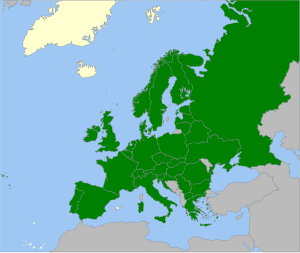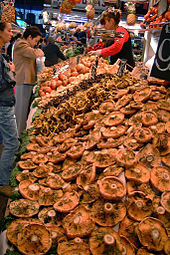Noble irritant
| Noble irritant | ||||||||||||
|---|---|---|---|---|---|---|---|---|---|---|---|---|

Noble irritant ( Lactarius deliciosus ) |
||||||||||||
| Systematics | ||||||||||||
|
||||||||||||
| Scientific name | ||||||||||||
| Lactarius deliciosus | ||||||||||||
| ( L .: Fr. ) Gray 1821 |
The Edel-Reizker or Real Reizker ( Lactarius deliciosus ) is a type of mushroom from the family of the deaf relatives (Russulaceae). Characteristic is the milky sap that escapes at injured areas, which, unlike other stimulus nuclei, is lively and unchanged in orange-red color. The fungus lives in symbiosis with pines . This is why the species is also called the pine blood stimulator . The agaric mushroom is considered a good edible mushroom. The urine turns red after consumption, but this is harmless. The Latin species name deliciosus means "delicious". The German name Reizker is a word of Slavic origin and can be translated with red milkling.
features
Macroscopic features
The hat reaches a diameter of 10 to 20 cm. The edge is often bent in a wavy manner. The hat skin is a bit sticky and frosted when dry. On an ocher-orange to brick-red background there is a pronounced darker zoning or a concentrically dripped pattern. The slats have a pale orange tone. In injured areas, they only turn green late. The spore powder is lightly colored. The stem is relatively short with a length of up to 5 cm and a diameter of about 2 cm. It is almost the same color as the hat and usually shows clearly separated, darker pits. The orange flesh is firm, hard and difficult to break. The milk is also colored orange. It later fades a little and finally turns a light green. The smell is pleasantly fruity, the taste mild.
Microscopic features
The elliptical spores are 7.2–9 µm long and 5.9–7 µm wide. Q value (quotient of spore length and spore width) is 1.2–1.4. The spore ornament up to 0.5 µm high and consists of a few warts and ribs, which are almost completely networked. The club-shaped basidia are 40–60 µm long and 9–11 µm wide and each carry 4 sterigms . The cheilocystidia occur in two modifications. First as spindle-shaped to awl-shaped, 25–35 µm long and 4–6 µm wide macrocystidia and then as cylindrical to slightly clubbed cystidia that are two to four times septate and 33–70 µm long and 4-7 µm wide. Both forms are few in number. The pleuromacrocystidia are fusiform to awl-shaped and 45–60 µm long and 6–8 µm wide and very sparse. The cap skin consists mainly of parallel, 2–6 µm wide, gelatinized hyphae.
Species delimitation
In the vernacular, the term Echte Reizker or Blut-Reizker is used to mean similar species, all of which are edible or at least non-toxic. A common and safe trait is their reddish milk, which sets them apart from inedible or poisonous milklings.
The alternating blue noble irritant ( Lactarius quieticolor ), which is sometimes classified as a variety of the noble irritant (see section systematics ) , is particularly similar .
The chip-green pine-irritant ( L. semisanguifluus ) and the wine-red pine-irritant ( L. sanguifluus ) are considered to be very good edible mushrooms . The former differs from the Edel-Reizker through the non-pitted stem and the dark green discolouring hats in older specimens. The latter forms a milk that quickly turns wine red at the interfaces.
The most common irritant, spruce-irritant ( L. deterrimus ), has a rather inferior taste than the relatives mentioned above. This species soon gets green spots at points of contact. It only occurs under spruce trees , its meat tastes distinctly bitter, the milk turns wine red after about 15 minutes and the hat is less zoned.
Another species that only grows under fir trees is the salmon irritant ( L. salmonicolor ). Its milk also turns wine red after up to 30 minutes. Its taste has a bitter component, which is why the mushroom is considered inedible by many mushroom pickers.
The shaggy birch milkling can look similar . However, it has a woolly hat and white, hot-tasting milk and can be found under birch trees.
Ecology and phenology
The Edel-Reizker is a mycorrhizal fungus that usually lives together with pine trees , especially Scots pine . It can be found in pine forests as well as in coniferous and mixed forests with pines in clear places or forest path edges. It can also be found in parks, gardens and similar biotopes. Very shady locations as well as very moist, for example waterlogged soils and subsoil heavily enriched with nitrogen are avoided. The fungus colonizes fresh to dry, mostly shallow soils over limestone , sand and primary rock . These are acidic to alkaline and slightly to moderately nutrient-rich.
The fruiting bodies appear mainly from September to October.
distribution
The Edel-Reizker is common in the Holarctic . It can be found in North America , Madeira , Europe, North Africa and North Asia ( Israel , Armenia , Eastern Siberia ). In Europe, the fungus is widespread, but very unevenly, from Belgium and the Balearic Islands via Italy , Serbia and Hungary to Russia and southern Finland in the north. It is more common in the east, but less common in the west and south. It is widespread in Germany, but of varying density.
Systematics
Numerous forms and varieties are known of the Edel-Reizker , which some authors also regard as independent species . These include the taxa hemicyaneus , pinastri , quieticolor and semisanguinascens . Today they are used as synonyms of the alternating blue noble irritant ( Lactarius quieticolor ). The species differs from the Edel-Reizker through a somewhat paler colored, young somewhat blue tinted hat. Microscopically, the Milchling has more spherical spores and, within the Deliciosi section, the most coarsely ornamented spores .
In the meantime, only the form rubescens is regarded as a subordinate taxon of the noble irritant . It is characterized by fruiting bodies, the milk of which turns reddish after a few minutes, while the type variety has been described as orange, unchanging milk. However, a corresponding color change often occurs after a few hours.
meaning
Food value
As an edible mushroom , the Edel-Reizker develops its pleasant, somewhat sweet taste through vigorous searing. However, its value suffers from maggot infestation, which occurs quite often with this fungus. All types of irritant kernels are less suitable for cooking , but better for frying . The urine may turn red after consuming the irritant core , but this is harmless.
Postage stamps
literature
- German Josef Krieglsteiner (Eds.), Andreas Gminder , Wulfard Winterhoff: Die Großpilze Baden-Württemberg . Volume 2: Stand mushrooms: inguinal, club, coral and stubble mushrooms, belly mushrooms, boletus and deaf mushrooms. Ulmer, Stuttgart 2000, ISBN 3-8001-3531-0 .
- Marcel Bon: Parey's book of mushrooms . Franckh-Kosmos Verlag, Stuttgart 2005, ISBN 3-440-09970-9 .
Individual evidence
- ↑ Josef Breitenbach, Fred Kränzlin (Ed.): Pilze der Schweiz. Contribution to knowledge of the fungal flora in Switzerland. Volume 6: Russulaceae. Milklings, deafblings. Mykologia, Luzern 2005, ISBN 3-85604-060-9 .
- ↑ Ewald Gerhardt: FSVO manual mushrooms . BLV Verlag, Munich 2006, ISBN 3-8354-0053-3 , p. 311.
- ↑ Hans E. Laux, Andreas Gminder : The great cosmos mushroom guide. All edible mushrooms with their poisonous doppelgangers. Franckh-Kosmos, Stuttgart 2010, ISBN 978-3-440-12408-6 , p. 432.
- ^ Lactarius deliciosus in the PILZOEK database. In: pilzoek.de. Retrieved September 15, 2011 .
- ↑ Worldwide distribution of Lactarius deliciosus. In: GBIF Portal / data.gbif.org. Retrieved September 14, 2011 .
- ↑ Jacob Heilmann-Clausen et al. : The genus Lactarius . Ed .: The Danish Mycological Society (= Fungi of Northern Europe . Vol. 2). 1998, ISBN 87-983581-4-6 , pp. 271-273 .
- ↑ Cvetomir M. Denchev, Boris Assyov: CHECKLIST OF THE MACROMYCETES OF CENTRAL BALKAN MOUNTAIN (BULGARIA) . In: Mycotaxon . tape 111 , 2010, p. 279–282 ( online [PDF; 578 kB ]).
- ↑ Z. Tkalcec, A. Mesic: Preliminary checklist of Agaricales from Croatia V . Families Crepidotaceae, Russulaceae and Strophariaceae. In: Mycotaxon . tape 88 , 2003, ISSN 0093-4666 , p. 289 ( online [accessed January 9, 2012]).
- ↑ DM Dimou, GI Zervakis, E. Polemis: Mycodiversity studies in selected ecosystems of Greece: I . Macrofungi from the southernmost Fagus forest in the Balkans (Oxya Mountain, central Greece). In: Mycotaxon . Vol. 82, 2002, pp. 177-205 ( online ).
- ^ S. Petkovski: National Catalog (Check List) of Species of the Republic of Macedonia . Skopje 2009 ( PDF, 1.6MB ( Memento from February 15, 2010 in the Internet Archive ) [accessed July 9, 2013]). National Catalog (Check List) of Species of the Republic of Macedonia ( Memento of the original from February 15, 2010 in the Internet Archive ) Info: The archive link has been inserted automatically and has not yet been checked. Please check the original and archive link according to the instructions and then remove this notice.
- ↑ Paula Baptista et al .: Diversity and fruiting pattern of macrofungi associated with chestnut (Castanea sativa) in the Tra's-os-Montes region (Northeast Portugal) . In: Fungal Ecology . Vol 3, 2010, pp. 9–19 , doi : 10.1016 / j.funeco.2009.06.002 ( online [PDF]).
- ^ TV Andrianova et al .: Lactarius of the Ukraine. Fungi of Ukraine. In: www.cybertruffle.org.uk/ukrafung/eng. 2006, accessed March 1, 2012 .
- ^ A b Jacob Heilmann-Clausen, Annemieke Verbeken, Jan Vesterholt: The genus Lactarius. (= Fungi of Northern Europe. Volume 2). Svampetryk, Mundelstrup (Denmark) 2000, ISBN 87-983581-4-6 .







